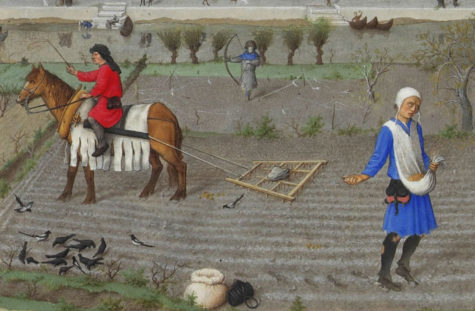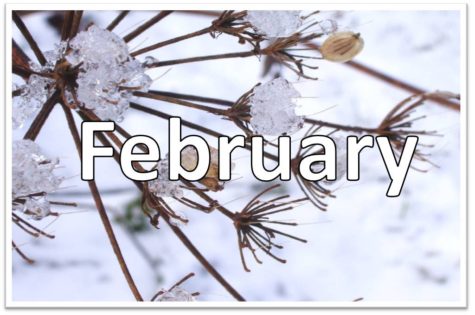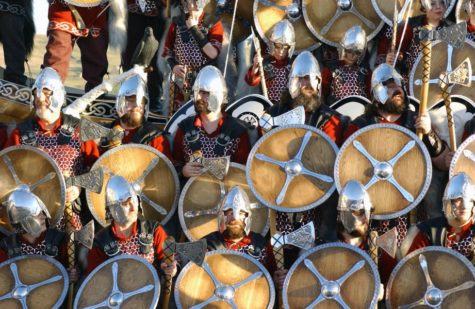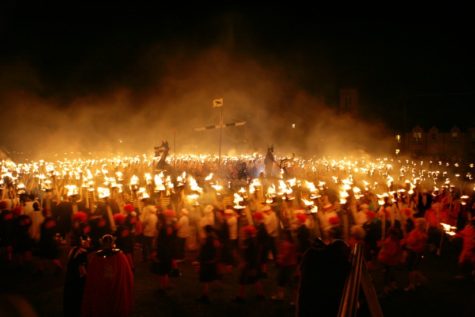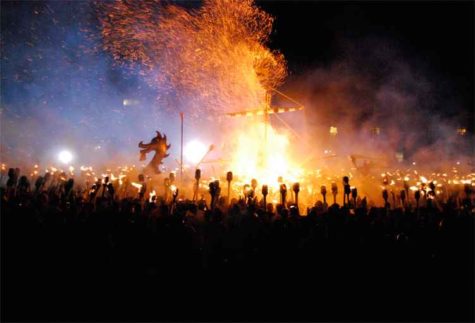- Time: Early to Mid-February, Normally Observed at First New Moon
- Focus: Disir, Goddesses and The Beginning of the Planting Season
- Overall: A time to honor the Disir (in a broad sense), Goddesses and those connected with the coming power of Spring – the Vanir, local land wights and Nerthus to name a few examples.
The Charming of the Plough, also referred to as Éowemeolc is the Anglo-Saxon early spring or pre-spring festival. It was clearly so early as to be more about seeing signs of spring than celebrating its arrival. The early date serves the purpose of doing the blessing before there is any danger of cultivation starting without it.
Charming of the Plow is a ceremony that marks the beginning of the planting season; when the first furrows are made in the fields. In the Old World that usually meant bonding with and asking for the blessing of Gods and Goddess, the local land spirits and perhaps anyone else who might help insure the crops are a success.
The Vanir, Nerthus and land wights are thus honored at this time for the coming Spring and to wish a healthy season for the crops. Farm tools are blessed and an offering of bread and mead/milk are traditionally given to the land wights upon the first furrows made into the earth. Even as a home gardener I like to do this each year.
Disting (Old Swedish: thing at the time of the sacrifice to the Disir~ which are female ancestral guardian spirits), is still modernly observed as an annual market in Upsalla, Sweden. Traditionally, it was a time when many would gather for the Thing of All Swedes, hold a great market and a special blot at the temple in Upsalla for the Disir.
Recorded as a regular feast only in Sweden, this blessing takes place in early or mid-February. The name means ‘Thing (assembly) of the Goddesses’. In Sweden, it was the first public moot/fair of the year; in Denmark, this is the time when the first furrows were ploughed in the field (an activity much hedged about with folk custom). This is a feast of new beginnings, at which the work of the year to come is blessed. this time, the Earth is prepared to have the seeds sown so that growth will take place in the land. Also, gifts may be given to the disir and elves at this time.
Dating The Blessing
Since the Icelandic months had become fixed, while the Anglo-Saxon months were fully lunar, it may not be possible to determine whether the blessing of the plow or earliest harbinger of spring festival was held at the same time in all Germanic areas—tied to the time of Yule—or whether it depended on local agricultural conditions, such as the beginning of lambing or the first partial thaw of the new year.
Whatever the traditional date for Blessing of the Plough, whether January or February, it would be in late winter or very early spring, well before an outsider might expect the first furrow to be cut.
These days we usually celebrate Éwemeolc/Blessing of the Plough on February 2—to coincide with the Celtic Imbolc, and because it is a cross quarter day, midway between Yule and Eostre/Ostara. This is the source of the American Groundhog Day celebration, because the spring equinox is 6 weeks away.
About the Name:
The Anglo-Saxon name refers to ewes (female sheep) giving milk because they have birthed their lambs. The Anglo-Saxons got much of their milk from sheep. This holy day has several names and several possible spellings. First and most obviously, “plough” is normally “plow” in the US. Other names include:
- Éowemeolc
- Éwemeolc
- Ewemeoluc
The second month of the Anglo-Saxon year, corresponding roughly to February was called Sólmónað. Bede writes: “Solmónaþ can be called the month of cakes, which [the Angles] offered to their gods during it.” However, no such word sol or sól is recorded in Anglo-Saxon, so some scholars think the month was actually named after the sun, but the sun is sunne in Anglo-Saxon.
So the other theory is that the month-name actually comes from sulh, “plough.” The cakes are presumed to have been offered by leaving them in the furrows; they may have been called “plough-cakes.”
This is one of the reasons modern Anglo-Saxon heathens celebrate Blessing of the Plough at this time. The other is that plows have clearly been blessed (or charmed) in England since at least Anglo-Saxon times.
About the Blessing:
This is a syncretistic charm—a melding of Christian and heathen elements—intended to cause a barren field to grow a good crop, or to reverse a spell that has been placed on the field. It also seems clear that blessing the plow and using it to cut the first furrow and then wetting it with a special milk mixture—which would presumably be ewe’s milk—relate as much to starting off any agricultural year in the best way possible as to reversing a curse.
The Field Blessing Charm:
Here is the remedy, how you can improve your fields if they do not want to grow well or when some harmful thing has been done to them by a wizard or poisonous sorcery. Take then at night, before dawn, four sods from four parts of the land and mark how they were before.
Take then oil and honey and yeast, and milk from each kind of livestock that may be on the land, and a piece of each kind of tree that may grow on the land, except for “hard trees”, and a piece of each plant / herb known by name except for glappan (burdock) alone, and then put holy water theron, and then drip it thrice on the base of the sods, and then speak these words:
Crescite, grow, and multiplicamini, and multiply,
et replete, and fill, terre, the earth.
In nomine patris et filii et spiritus sanctu sit benedicti.
And the Pater Noster as often as the other one. And after that, carry the sods to church, and a mass-priest should sing four masses over the sods, and one should turn the green side towards the altar, and afterwards one should take the sods to where they were previously, before the setting of the sun.
After this, four crosses are made from branches, inscribed with the evangelists names, and buried face-down in the pits from which the sods were taken.
When all that is done, then let someone take unknown seed from beggars and give them twice as much as he took from them, and let him gather all his plowing gear together; then bore a hole into the plow beam putting into it incense and fennel and hallowed salve and hallowed salt. Then take that seed, place it on the body of the plow, then say:
Erce, Erce, Erce, mother of the earth,
may the almighty grant you, the eternal lord,
fields growing and flourishing,
increasing and strengthening,
high shafts, bright fruits,
and the abundant barley-growth,
and the white wheat-growth,
and all growth of the earth
May the etrnal lord grant him,
and all his holy ones, who are in heaven,
that his produce may be defended against all enemies,
and that it be protected against all evils,
against poisonous sorceries sown over the land.
Now I ask that the ruler, he who shaped this orld,
that there may be no speaking-woman or a skilful man
who can turn to naught words thus spoken
Then let someone drive forth the plow and open the first furrow: then say:
May you be well, earth, mother of men!
May you grow in God’s embrace,
filled with food for use by men.
The original text of the charm may be found here: Metrical Charm For Unfruitful Land
Sources:
The Celtic calendar denotes February 4 as King Frost Day. This old English festival is designed to fight the boredom of winter with a celebration asking for a quick arrival of spring.
In London, a fair was held to honor King Frost Day. People would gather at the river Thames, which was completely frozen over, to petition the King of the Frost to bring on Spring. This annual celebration understandably came to an abrupt end during World War I. Along the Welsh border, some still celebrate this day by gathering snowdrops.
King Frost reigned with the Queen of the Snowflakes. Today is a good day to work Snow and Ice Magicks. You can also decorate your home and work spaces with representations of winter, icicles, and snowflakes.
If you’re in a cold climate, go ice skating, attend a hockey game, build a snowman, or go cross-country skiing—or sit inside by the fire with a cup of cocoa and watch the snow fall outside. If you’re in a warm climate, eat ice cream or build an ice sculpture and watch it melt. Take joy in the cold, clean attributes of King Frost.
Collected from various sources
What follows is a list (in alphabetical order) of the names given to the February moon. Also listed is the tradition and/or origin of that moon name:
- Avunnivik Moon ~Inuit
- Big Winter Moon ~other
- Bony Moon ~Cherokee
- Chaste Moon ~other
- Cleansing Moon ~other
- Coyote Frighten Moon ~San Juan
- Dark Storm Moon ~Janic
- Geese Moon ~Omaha
- Gray Moon ~Pima
- Horning Moon ~other
- Hunger Moon ~Janic, Algonquin
- Ice Moon ~Celtic
- Lateness Moon ~Mohawk
- Little Bud Moon ~Kiowa
- Little Famine Moon ~Choctaw
- Long Dry Moon ~Assiniboine
- Nuts Moon ~Natchez
- Old Moon ~Cree
- Purification Moon ~Hopi
- Running Fish Moon ~Winnebago
- Quickening Moon ~other
- Rabbit Moon ~Potawatomi
- Raccoon Moon ~Sioux
- Red Moon, ~other
- Shoulder Moon ~Wishram
- Snow Moon ~Neo-Pagan, Algonquin
- Solmonath Moon ~other
- Sparkling Frost Moon ~Arapaho
- Spruce Tips Moon ~Passamaquoddy
- Storm Moon ~Medieval English
- Sucker Moon ~Anishnaabe
- Trapper’s Moon ~Algonquin
- Trees Pop Moon ~Sioux
- Wild Moon ~other
- Wind Moon ~Creek
- Winter Moon ~Taos
- Wolf Moon ~other
Correspondences for February
- Nature Spirits: house faeries, both of the home itself and of house plants
- Herbs: balm of Gilead, hyssop, myrrh, sage, spikenard
- Colors: light blue, violet
- Flowers: primrose
- Scents: wisteria, heliotrope
- Stones: amethyst, jasper, rock crystal
- Trees: rowan, laurel, cedar
- Animals: otter, unicorn
- Birds: eagle, chickadee
- Deities: Brigit, Juno, Kuan Yin, Diana, Demeter, Persephone, Aphrodite
Power Flow: energy working toward the surface; A good time for spell work on purification, growth, healing. Loving the self. Accepting responsibility for past errors, forgiving yourself, and making future plans.
About The Month of February
February was named for the Roman goddess Februa, mother of Mars. As patroness of passion, she was also known as Juno Februa and St. Febronia from febris, the fever of love. Her orgiastic rites were held on February 14th, St.Valentine’s Day. In Norse traditions, she is equated with Sjofn.
The Irish called this month Feabhra or an Gearran, the gelding or horse. The horse was used to draw the plough, but Gearran also means ‘to cut’ and ‘Gearran’ can be used to describe the ‘cutting’ Spring winds. To the Anglo-Saxons, this was Solmonath, “sun month,” in honor of the gradual return of the light after the darkness of winter. According to Franking and Asatru traditions, this month is Horning, from horn, the turn of the year.
The first full moon of February is called the Quickening Moon. It shares the titles Snow Moon with January and November, Wolf Moon with January and December, and Storm Moon with March and November. February’s Moon is also called the Hunger or Hungry Moon, and it has been called the Ice, Wild, Red and Cleansing, or Big Winter Moon.
The month of February, truly a month of ice in many parts of the Northern Hemisphere, is a dormant time, when all activity and life appears to be low-key or below the surface movement. In both the Celtic and Roman cultures, it was a time of spiritual purification and initiation. The country of Tibet celebrated the conception of Buddha and the Feast of Flowers during this time of year.
Aquarius and Pisces share power over February, with Pisces taking over around the 19th of February. Violet is the flower for those born in February. Though hyacinth and pearl appear on some lists, amethyst is the jewel for those born in this month and for Pisces, while aquamarine is the stone for Aquarians. Other stones associated with Aquarius are chrysoprase, garnet, labradorite, lapis lazuli, and opal. Albite, aquamarine, chrysoprase, fluorite, green tourmaline, labradorite, moonstone, and opal are linked to Pisces.
February can be an ideal time for dedicating or re-dedicating oneself to whatever deity or deities one worships. It is also a wise practice to cleanse and purify yourself, your dwelling place, and even your property lines before the dedication. Purifying changes the vibrations by removing negative ones and inviting in positive ones. The month of January was a time of ending old cycles and preparing for new ones. February prepares the environment and the body, mind, and spirit for receptivity of new spiritual and life experiences.
February Celebrations:
Hatun-pucuy, or the Great Ripening, was celebrated among the Incas.
The Lesser Eleusinian Mysteries of Greece was also called the Festival of the Returning Daughter. This was a celebration of the Kore’s return from the Underworld and the rebirth of earthly vegetation. This ceremony, unlike the Greater Eleusinian, was open to many people and was a time of initiation into the lower Mysteries. Initiation into the Lesser Eleusinian Mysteries was open to all free men and women who were not guilty of murder and similar crimes. All initiates were bound by an oath of silence so effective that the secrets of the mysteries were never told. Today we know very little about the actual ceremonies, except what was performed in full public view.
Kuan Yin is the Great Goddess of the Oriental people. She has been known to offer her aid primarily to women and girls, but there is no reason why men cannot honor her and ask her help. She is said to guide lost travelers, protect from attack by humans or animals, bless a family with children, and heal. She is called the Compassionate and is revered for her wisdom and love. Oriental women offered oranges and spices before her statues.
The Roman Lupercalia festival was a time of purification and fertility. A priest of the god Pan signaled the beginning of the Lupercalia with sacrifices of a goat and a dog. The skins of these animals were made into whips which chosen young boys used to strike people, particularly barren women. This was thought to bring good luck in conceiving and having a healthy baby. It is quite possible that our present Valentine’s Day has seeds of its beginnings in this ritual.
The Roman Parentalia and Feralia celebrations were a time to honor the ancestors. It was a period of solemnity with no feasting or marriages; all the temples were closed. Houses were cleaned thoroughly and food offerings made to the spirits of the dead. The goddesses Mania and Vesta were honored with solemn rituals.
The priestesses of Vesta (the Vestal Virgins) were accorded great respect and trust. They kept the wills of the citizens of Rome and saw that they were properly fulfilled when the maker died. At a word or appearance of any Vestal, any condemned criminal was set free without question or argument.
Later in the month, the festival of Carista was held as a family celebration for peace and accord. This festival was known as the Concordia. Condordia, or Caristia, was the goddess of harmony. It was a time for exchanging gifts with family members and resolving problems. Differences and feuds were not to be carried within the family beyond this date.
The Roman god Terminus was the deity of land boundaries. His festival was the Terminalia. Boundary stones marking the property lines were anointed and blessed by the head of the household. This ceremony is rather like the one honoring the household guardians, as the Nature spirits residing in the boundary stones were asked for protection and prosperity for the land and family. This ritual could be adapted for today by blessing the boundaries of your property, stones or not.
Sources: Moon Magick and Angelfire
Baking is appropriate for celebrating Imbolc, and we often make Crescent cakes for the end of our Imbolc ritual. Here is our circle’s favorite recipe:
- 1 1/4 cups Flour
- 3/4 cup Sugar
- 1 cup Finely Ground Almonds
- 3 drops Almond Extract
- 1/2 cup Butter or Margarine, softened
- 1 tablespoon Honey
- 1 Egg Yolk
In a large mixing bowl, combine the first four ingredients. Add the butter, honey and egg yolk and mix together well. Cover with aluminum foil or plastic wrap, and then chill for 1 1/2 to 2 hours in the refrigerator.
When ready, pinch off pieces of the dough (about the size of plums) and shape them into crescents. Place the crescents on a well-greased cookie sheet and bake in a 325-degree preheated oven for approximately 20 minutes. This recipe yields 20 to 25 crescents.
From Rose Ariadne
The last day of each of the lunar months is the sacred day of the triple goddess of crossroads and the patroness of Witches, Hekate.
Hekate had many names and titles: Hecate Trevia, “of the three ways”; Hecate Phosphoros, “the light bringer”; Hecate Nykterian “of the night”; and Hecate Basileia, “Hecate Queen.” On this night of the waning Moon we have a perfect opportunity to work with this goddess and ask for her blessing to illuminate our darkest times, and grant us her protection.
Hecate, goddess of the crossroads, hear my cry,
Protect and guard me under your midnight sky.
Hecate Phosphoros “she who brings the light,”
Hecate Trevia bless me with your wisdom tonight.
Hekate’s ancient devotees held dinners in her honor, known as Hekate Suppers. Once upon a time, these dinners were consumed outside under the dark moon, ideally at a crossroads. One plate was reserved for Hekate; after her devotees dined, just before they departed, Hekate’s plate was laid down at the crossroads.
Foods associated with her were prepared. The entree was usually fish, especially red mullet. Devotees feasted and celebrated. Offerings and leftovers were placed outside the door or at a crossroads for Hekate and her hounds.
Even way back when, cynics scoffed that food placed outside was actually consumed by feral dogs and homeless people without realizing that this is Hekate’s intent: this is one way she accepts offerings. (The Church was still trying to eradicate this ritual as late as the eleventh century.)
A typical Hekate Supper menu includes eggs, fish roe, goat and sheep cheese, sprats, red mullet – a scavenger fish that was the subject of many taboos – garlic, mushrooms, and honey cake surrounded by blazing torches or cakes decorated with miniature imitation torches (candles). Other ideas include garlic, salmon, honey, and edible flowers.
Traditionally whatever is given to Hekate cannot be reclaimed. Thus, do not break out your priceless set of china; lay the meal on the ground or use a serving dish that will be incorporated into the offering. Once the offering is laid down, depart without looking back. Hekate determines who picks up the offering.
Smaller, private offerings may be left at a crossroads, too:
- Place offerings on a plate or flat stone and leave them at a crossroads after dark.
- Make your invocation and then walk away without looking back.
- Do not return for the plate, or any part of the offering, but consider it part of your gift.
Offerings can include the following:
- Eggs
- Garlic and honey (especially lavender honey)
- Croissants and crescent shaped breads and pastries
- Candles
- Incense
- Images of dogs, especially black dogs
- Actions on behalf of dogs
Encountering or hearing a dog is an indication that your petition has been heard.
Other nights sacred to Hekate:
- Friday the 13th – particularly if it falls in the month of August.
- November 16th is Hekate Night
- August 13th, in Italy, a festival is shared between Diana and Hekate
Sources:
- Invocation by Ellen Dugan
- The Powers That Be
January 31 is Disfest or Disablot which is a day of sacrifice honoring the Disir. The Disir are all the female relatives from the eons of time that have passed over and over see as well as protect their living family members.
In some homes every candle and light is lit in the house to honor them. A sacrifice of the very best food and drink in the house is given to the Land Wights as well. It is a day of remembrance and honoring the females that passed over and to thank them for their loving protection.
Source: Pagan Calendar
Up Helly Aa refers to any of a variety of fire festivals held in Shetland, in Scotland, annually in the middle of winter to mark the end of the yule season and celebrate the arrival of the Vikings. Traditionally held on the last Tuesday in January, the festival involves a procession of up to a thousand guizers in Lerwick and considerably lower numbers in the more rural festivals, formed into squads who march through the town or village in a variety of themed costumes.
The current Lerwick celebration grew out of the older yule tradition of tar barreling which took place at Christmas and New Year as well as Up Helly-Aa. After the abolition of tar barreling, permission was eventually obtained for torch processions. The first yule torch procession took place in 1876. The first torch celebration on Up Helly-Aa day took place in 1881. The following year the torch lit procession was significantly enhanced and institutionalized through a request by a Lerwick civic body to hold another Up Helly-Aa torch procession for the visit of the Duke of Edinburgh. The first galley was burned in 1889.
There is a main guizer who is dubbed the “Jarl”. There is a committee which you must be part of for fifteen years before you can be a jarl, and only one person is elected to this committee each year.
The procession culminates in the torches being thrown into a replica Viking longship or galley. The event happens all over Shetland, but it is only the Lerwick galley which is not sent seaward. Everywhere else, the galley is sent seabound, in an echo of legendary Viking sea burials.
After the procession, the squads visit local halls (including schools, sports facilities and hotels), where private parties are held. At each hall, each squad performs its act, which may be a send-up of a popular TV show or film, a skit on local events, or singing or dancing, usually in flamboyant costume.
Due to the often-flamboyant costumes and the large quantity of males dressing up as females (Traditionally, the Capital festival does not permit women to partake in the squads) in the Lerwick festival, it has earned the joke name ‘Transvestite Tuesday’. The photos below show a few examples of the festival’s highlights.
Source: Wikipedia
Official Website: Up Helly Aa
Called Feriae Sementivae, this one or two day Roman festival was moveable, but generally began between January 24 and January 26. Sacred to Tellus, and Ceres, this festival was for the protection of seeds, either those sown the previous fall, or those to be sown in the spring. During Sementivae plowing oxen were decorated with garlands, and puppets or masks were hung from tree branches.
This is an excellent time to begin to think about planting a “Witch’s Garden” and to do spellwork involving seeds. Spiritually and metaphysically, this is an optimum time to sow the internal seeds of what we hope to bring forth as the year unfolds.
- Presiding Goddess: Nokomis
- Themes: Prosperity, Luck, Providence
- Symbols: Gold, Golden items, Corn
About Nokomis: In Algonquin tradition, Nokomis is the “grandmother” who supplies us with the earth’s riches and gives nourishment to humankind in times of need. When people are hungry, Nokomis provides food. When there is no food to be found, she offers to let us consume her spirit, thereby continuing the cycle of life.
To do Today: Today marks the anniversary of the discovery of gold in California and the resulting expansion westward in the United States. In keeping with this prosperous, fortunate theme, wear or carry something gold today to bring a little more of Nokomis’s abundance your way.
For financial improvements, especially if you have any pressing bills, eat corn (any type) today. Before consuming it pray to Nokomis, saying:
“Grandmother, see the sincerity of my need.
Go to your storehouse and dispense _____
(fill in the minimum amount you need to get by)
so that I might meet my obligations.”
Eating the corn internalizes the energy of the prayer so opportunities to make money start manifesting.
If you’re pressed for time, grab a kernel of unpopped popcorn and put it in your wallet or purse to keep Nokomis’s prosperity (and your cash) where it’s needed most.
The History:
In January of 1848, James Marshall had a work crew camped on the American River at Coloma near Sacramento. The crew was building a saw mill for John Sutter. On the cold, clear morning of January 24, Marshall found a few tiny gold nuggets. Thus began one of the largest human migrations in history as a half-million people from around the world descended upon California in search of instant wealth.
From: 365 Goddess and other sources


